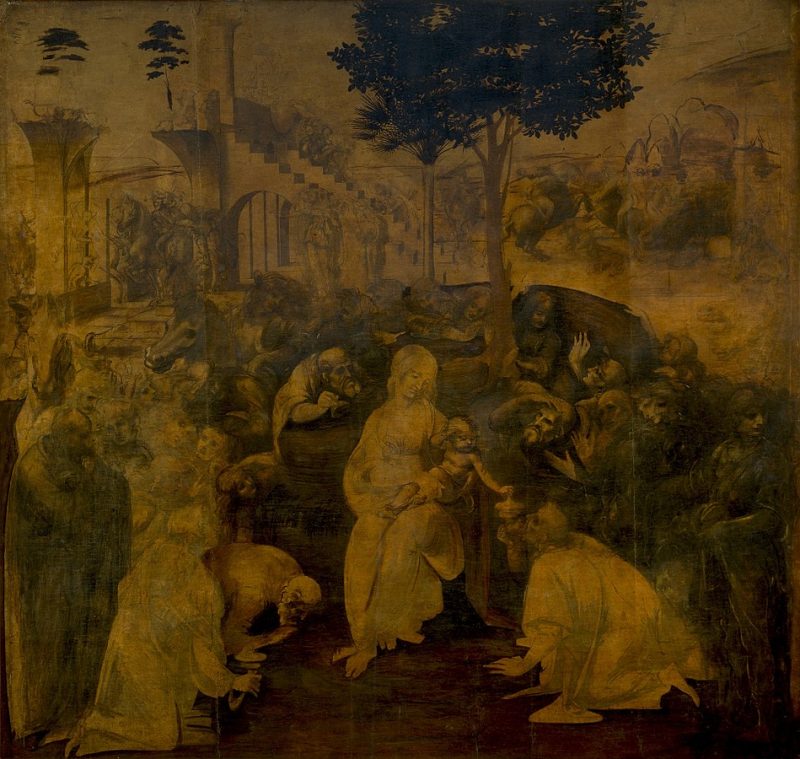Florence has an impressive collection of paintings. So the task of choosing its top masterpieces is a tad challenging. But we do like a challenge. So we’ve made a shortlist of the famous paintings in Florence that you absolutely can’t afford to miss, all of which can conveniently be found in the Uffizi Gallery. Seeing these works of art will make a visit to Florence unforgettable. So get out your notebooks and prepare for a full immersion in Renaissance beauty.
Famous paintings in Florence – The VIPS of the Uffizi
The Uffizi Gallery steals the spotlight when it comes to famous paintings in Florence. It hosts the most important collection of Italian Renaissance art in the world. Here you’ll find iconic works by some great artists such as Leonardo, Raffaello and Botticelli. And the only surviving panel painting by Michelangelo.
Leonardo da Vinci – Adoration of the Magi (1481)
Being face to face with one of Leonardo’s works is awe-inspiring. In this painting it’s the complexity of the composition, with Mary and the Magi forming a triangle in the foreground and a mass of moving figures in the background, that is really striking.
It’s an early work that he left unfinished, where Leonardo is trying out his revolutionary technique of the sfumato. This style of painting, “without lines or borders”, became one of his distinctive trademarks. The “Adoration of the Magi” shocked his contemporaries with its modernity and marked an irreversible shift in the history of painting.
Read more about Leonardo’s Adoration of the Magi, which had been recently restored. See all the paintings by Leonardo that can be admired in the Uffizi.

Michelangelo Buonarroti – Tondo Doni (1504)
Don’t miss this whatever you do. This is one of the few paintings by Michelangelo as he preferred to express himself through sculpture. By the time he painted the “Tondo Doni” he was already a legend, having sculpted the Pietà and the Statue of David.
Here the Holy family is depicted in a circular painting (tondo means ’round’ in Italian), where the figures and shapes are sharply drawn, as if carved in marble. The use of bright colours and the naked figures in the background, whose meaning has been much debated, is also feature in the Sistine Chapel.
=> Why is the Uffizi Gallery one of the world’s top museums?

Sandro Botticelli – Allegory of Spring (1482) and Birth of Venus (1482-85)
Of all the famous paintings in Florence, these are probably the best known, thanks to the countless imitations of his paintings over the years. In the recently renovated Botticelli Rooms of the Uffizi you’ll come to face to face with two of his most iconic productions.
Venus, the Goddess of Love, comes ashore on a shell from the sea where she was born, and the divinities that celebrate Spring, act out a sensual play on a tapestry-like background in the Primavera (Allegory of Spring).
These works mark the first appearance of a classical allegory in Florentine painting. While the meanings are complex, filled with mythological references, the aesthetic effect is clear to everybody. The light, the details, the grace of the figures, speak of an ideal world where Love and Beauty have a deep spiritual significance. A world where contemplating beauty is like gazing upon the face of God. Once you’ve seen these paintings you may well agree.
Read more about the meaning of Botticelli’s “Birth of Venus”.

Raphael – Madonna of the Goldfinch (1506)
Raphael learned his lessons from Leonardo da Vinci when painting his Madonna. Mary, the infant Jesus and Saint John the Baptist tenderly group around a little bird, with a Leonardo-esque landscape in the background. The goldfinch represents Christ’s crucifixion.
Legend says that the little bird flew to Christ’s crown to get a thorn and was stained by Christ’s blood, hence its red marking. This painting ranks as one of the finest achievements of High Renaissance art by virtue of the harmony conveyed through the simple colours and composition.

Titian – The Venus of Urbino (1538)
This is one of the most erotic, and iconic, images of all time. In the painting Venus is lying unapologetically naked on a bed, without any of the allegorical symbols that usually accompany her. She’s much more human than divine.
Given the shameless sensuality, it’s funny to think that the picture was supposed to serve as an instructive piece for the commissioner Guidobaldo della Rovere’s young bride. The dog sleeping at her feet is a symbol of fidelity, while the roses in her hand recall love.
=> Learn some curious facts about the Uffizi Gallery in Florence!
Filippo Lippi – Madonna and Child (1460-65)
You’re likely to have seen this picture reproduced countless time. It’s one of Lippi’s last paintings and critics agree it is one of the triumphs of the Renaissance. The Madonna wears a fashionable Florentine gown, suggesting that her beautiful face might bear the features of Lippi’s lover, Lucrezia Buti.
Lippi was a chaplain at a convent near Florence, and there he madly fell in love with the novice Lucrezia. The two ended up running away together. The Madonna here has a graceful but earthy beauty, and the angel in the foreground looks at us with a playful, almost mischievous, smile. Reality has entered the world of painting, and so have sensuality and sinuous detail. Botticelli was Lippi’s pupil and learned a lot from his master, as one can see from the lovely details of Mary’s veil.
Art passionate? Discover the best frescoes to be found in Florence, and all the city’s most famous Renaissance masterpieces.
=> 7 Curious facts you should know about the Uffizi Gallery!


